Part One
The larvae in the photograph below came from 1 cubic foot of soil in a raised nursery bed of beautiful candelabra primulas I had brought in to pot up for fund raising for charity. I had to dig out the entire 4ftx4ft bed and extract wash and treat 40 plants in April. The adult was hiding in a dahlia flower along with the usual complement of earwigs last September.

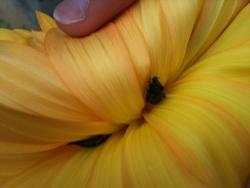
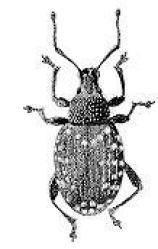
This article is divided into sections for easy reference:
1. Plants at greater risk
2. The warning signs that they may be present
3. The insect and its stages
4. Chemical control
5. Biological control
1. Plants at greater risk
Among the many plants that are at risk are vines, rhododendron and azaleas, bergenias, heucheras, primulas, cyclamen, heathers, pines and taxus, strawberries and other rosaceae (though I have only come across them on the fruit side), and sedums. This list is not exhaustive, and some get infestations of the weevil, and some of the weevil and grubs.
The weevil has to walk everywhere because it has a sealed case and cannot fly, but it has hooked feet and can walk up walls and across ceilings. It commonly gets around by hitching a lift to your garden from a plant you buy in a garden centre or nursery.
Therefore, any plant you bring into your garden is worth checking, particularly if it is a plant they like. I dose all incoming plants with larvae killer.
2a. The warning signs that adults may be present
The insect eats a different diet as an adult than as a grub. As an adult the weevil eats notches into leaves, or eats the tips of needles, in a wide range of plants. The weevils may feed on one set of plants and lay their eggs on the surface of soil for another set of plants. For example, it is unusual to come across an adult on primulas, but common to find the larvae under the soil if adults are nearby. You can also have a large azalea or rhododendron that is too tough and too mature to be killed by the grubs, but it can serve as a host for the adults to wander off to lay their eggs on nearby smaller plants.

Foliar feeding takes place at night, though the weevils will also venture out on heavily overcast days. If you disturb it on a plant, the adult drops to the soil, typically upside down, and plays dead. It is black, so it is difficult to see against the ground.
2.b The warning signs that the larvae may be present
Look for weak or discoloured leaves on young plants where plants are not thriving. Look for plants that remain wilted even when the soil is moist. What is happening here is that the leaves are transpiring more water than the root system can replace because the roots are being destroyed by the larvae. They may also girdle the main stem under or just above the surface.
The larvae are voracious feeders, with small grubs maybe 12 inches underground, and more mature larvae closer to the soil surface. The reason for this seems to be that the bigger grubs have bigger appetites and move closer as they mature to nip into larger roots near the surface. As they do this, they cut off major roots just below the soil, leading to the complete destruction of the root systems. Clearly, if they cut the roots at the top, everything below dies.
Often this damage is greatest in spring, before plants start their new growth. What happens then is that the plant attempts to grow leaves and blooms, but does not have the roots to deal with the water requirements through transpiration. You notice the plant wilting and you water it, but it is a root problem, not a water problem, and unless you lift the plant, cut back all the foliage, clean out all the pests, and put it in a recovery phase to grow more roots, it probably will die. In the first photograph of a candelabra primula below, the root system looks ok. However, when you see the larvae you know you are in trouble.
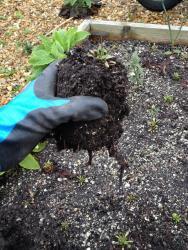

Then when you wash down the root system you see the full extent of the damage the larvae have done.
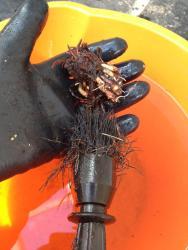
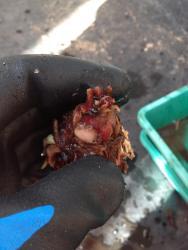
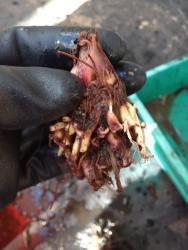
This plant will try to grow, and the leaves it puts out will seal its fate.
3. The insect and its stages
The adult is a hard-shelled weevil about half an inch long as an adult, black with yellow spots. Every adult is female and lays between 200 and 1,000 eggs. These hatch into larvae, and they go through a number of stages, called instars, before emerging as fully developed adults 16 to 30 weeks later. Here is an adult hiding down the side of a pot, then calmly marching off when found. Don't worry. It didn't get far.
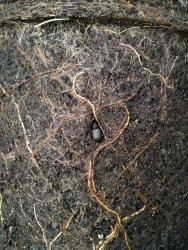
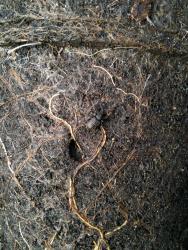
The larvae are white with a brown head and pincers, usually appearing as a C-shaped grub. However, they do move by undulation, pulling themselves forward with the mandibles. I have also observed them nipping other larvae around them to get them out of the way, and I am guessing they are establishing a pecking order as they seem to square up before one moves away. In the earlier instars they are legless, but as they get near to pupating they generate their legs and the larvae take on the characteristic three-part insect appearance (head, thorax, abdomen), though they are still white or pinkish/yellow with a brown head.
The smaller grub is deepest in the soil, feeding on finer roots. The larvae increase in size through six or seven stages, migrating closer to the surface and up to the biggest roots as their appetite and mouth size increase. The larvae mature depending on temperature and the availability of food, from about 75 days in one season to maybe 225 days if they have to overwinter and settle down for the cold months in underground chambers. Larvae can survive being frozen, I have read.
Pupation takes about 21 to 24 days. A few days after emerging they turn brown from white, then black. The adults emerge in spring or early summer, earlier in greenhouses from overwintered larvae. The adult then engages in maturation feeding while developing its ovaries, and the speed of the development seems to depend on heat and quality of food source, from 20 to about 50 days. Eggs are laid at night into crevices on the plant where the adult is feeding, dropped to the ground, or laid in the hiding place of the adult during the day. Eggs are small, and the round brown balls you find with acid plants are usually slow-release fertilizer rather than vine weevil eggs.
The insect hides in debris on the ground, down the sides of pots, in flowers where there are multiple petals, and sometimes just under the surface of the soil. The weevils feed most heavily as they mature, and they eat less when they move into the egg-laying phase. Adults generally live about 90 to 100 days.

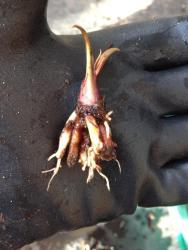
4. Chemical control
There are few products available to the hobby gardener, and those that are available seem to cost more than Napoleon brandy.
Even some of the best insecticides for the professional growers have been delisted, so this pest is on the up curve at present. The suggestion is that you buy the product and use it to soak pots that may house the larvae. The only problem you have is that 750ml of chemical is used for soaking 150 litres of pots, but if you pour that mix into the pots, they absorb it and it does less than half of what you expect. In my experience it costs about 40 cents to treat an 8-inch pot. This is fine if you have 10 pots, but not so good if you have 100.
The other chemical problem is that the weevils are extremely tough, and when you dose them with something that kills them, you have killed everything else on the same insect spectrum, including any predators they may have. These weevils eat leaves and needles that are toxic to most insects, so they are pretty resistant. Strangely, through the law of unintended consequences, the active ingredient in some slug pellets, methiocarb, also knocks off some of the weevil killers, the Carabid beetle for example.
An example of the insect dynamics is presented in this quote from Richard S. Cowles of the Connecticut Agricultural Experiment Station: “In one field-grown yew nursery, where insecticides had been intensively used, I found (in a pitfall trap survey) approximately 1,500 black vine weevils and 200 predatory ground beetles. At the same time, in an unsprayed nursery, and with the same trapping effort, I recovered three black vine weevil adults and 950 predators.” The suggestion here is that if you blanket-bomb the weevil, you kill off the predators, and the consequence is that you may end up with only weevils.
I don’t treat mature plants against the adult weevil. Anything that I might spray or use to kill the adult weevil probably would kill me. I kill them by hand when I see them. The war is against the larvae.
Where I see the problem arising, I dig out the plants that are at risk, split them, soak them in larvae killer, and repot them in fresh compost. In the middle photograph below, on the Primula secundiflora, the roots on the right are a little chewed, while those on the left are perfect.



5. Biological control
Another effective method of controlling black vine weevils in container-grown nursery stock includes the use of entomopathogenic nematodes (Cowles et al. 1997, Gill et al. 2001). These nematodes, or roundworms, are almost microscopic pathogens of insects. They search through moist soil for susceptible insects, enter into their body cavity, and release symbiotic bacteria, which quickly multiply and kill the host. Two or three generations later, the infective juvenile stage of nematodes emerges from the bacterial-soup remnants of the dead insect, to seek out new hosts. Therefore, because they propagate in hosts, the application of nematodes may lead to improved control of root weevil larvae over time. Mr. Cowles' studies indicate that black vine weevil larvae are susceptible to virtually any commercially available species, including Steinernema carpocapsae, S. feltiae, and Heterorhabditis bacterio-phora (Cowles 1997).
You can buy these live nematodes in a sealed packet, about the size of the old cigarette packs, and mix a slice of the material with a gallon of water. The nematode-infused material is like cotton wool and it does not mix very well in water. I also don’t know whether using normal tap water, which is chemically treated to be fit to drink, may also kill the nematodes. I pour water into the watering can and let it reach room temperature over a day before I use it. That should let some of the chemical content burn off. You can see one variety of the nematodes below.
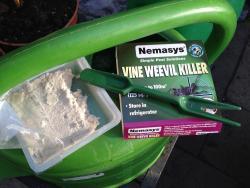
Then you just dose the pots as below, or what I think I will do next time is soak the pots in a tray so that the overflow can be recycled. It is also probably a good idea to water the pots well a couple of days earlier so that the soil is already moist. The little nematode worms seem to need a moist environment to swim around. The pots and soil also need to stay moist for a couple of weeks.
The nematodes need about 40F as a base temperature, so it is best to apply them between March and November. The vine weevil larvae seem able to keep mobile and growing at temperatures below that. The nematodes are easy to apply.
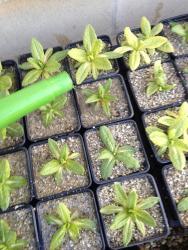
The particular nematodes used for this purpose are in the genera Steinernema, with control of the vine weevil relying on bacteria carried in the eelworm's digestive system. On contact with weevil larvae, the nematodes enter through orifices, or directly through the cuticle, and their cargo of bacteria is released. The bacteria cause septicemia and the internal breakdown of weevil larvae tissues, which are then consumed as a "soup" by the nematodes. They are thus parasites and can survive only by infecting larvae.
It strikes me that you need to be very careful with your handling of soils that have been dosed with this nematode, and wear gloves. I know I do.
I did a treatment in April, and I probably will do another in August and maybe again in October. They are at the top of my hit list after what they did to my primulas. However, have a look at Part Two to see how you can turn their predations into an opportunity to grow more plants.
I would like to credit some of the references for this, from people wiser and more experienced than I.
http://www.cyclamen.org/weevil...
Black Vine Weevil Biology and Management
Journal of the American Rhododendron Society
Richard S. Cowles
James R. Baker, Extension Entomologist Emeritus & S. Bambara, Extension Specialist
| Thread Title | Last Reply | Replies |
|---|---|---|
| Superior! by greene | Jun 23, 2014 12:52 PM | 8 |